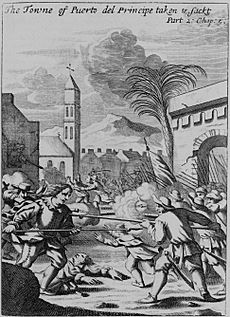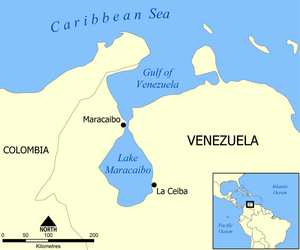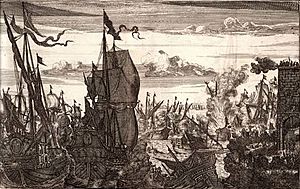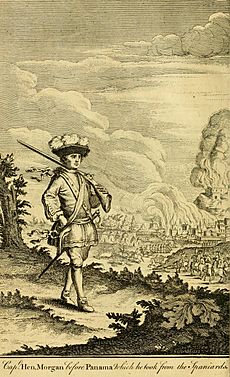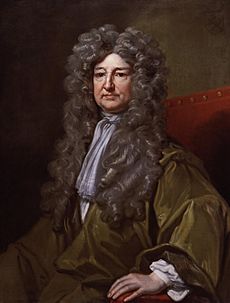Henry Morgan facts for kids
Quick facts for kids
Henry Morgan
|
|
|---|---|
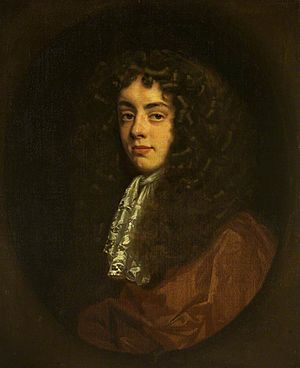
Portrait in the style of Peter Lely, c. 1680
|
|
| Born | c. 1635 Llanrumney or Pencarn, Monmouthshire, Wales
|
| Died | 25 August 1688 (aged 52–53) Lawrencefield, Colony of Jamaica
|
| Piratical career | |
| Allegiance | Kingdom of England |
| Years active | 1663–1671 |
| Later work | Lieutenant Governor of Jamaica |
Sir Henry Morgan (born Harri Morgan; around 1635 – 25 August 1688) was a famous Welsh privateer. A privateer was like a government-approved pirate, allowed to attack enemy ships. He later became a plantation owner and the Lieutenant Governor of Jamaica. From his base in Port Royal, Jamaica, he led many raids. He attacked Spanish towns and ships in the Caribbean, becoming very rich. With the money he earned, he bought three large sugar plantations on the island.
Contents
Sir Henry Morgan: Early Life and Rise to Fame
Much of Henry Morgan's early life is a mystery. He was born in a part of Monmouthshire, Wales, which is now near Cardiff. No one knows exactly how he got to the West Indies or how he started his career as a privateer. He might have been part of a group of raiders led by Sir Christopher Myngs in the early 1660s. This was during a war between England and Spain.
Morgan became good friends with Sir Thomas Modyford, who was the Governor of Jamaica. In 1667, when England and Spain had more problems, Modyford gave Morgan a letter of marque. This was a special license that allowed him to attack and capture Spanish ships.
First Raids: Puerto Principe and Porto Bello
Morgan quickly led successful and very profitable raids. He attacked Puerto Principe (now in Cuba) and Porto Bello (now in Panama). In 1668, he sailed to Maracaibo and Gibraltar in modern-day Venezuela. He raided both cities, taking their wealth. Then, he cleverly destroyed a large Spanish fleet to escape.
Morgan's letter of marque allowed him to attack Spanish ships at sea. It did not officially allow attacks on land. Any treasure from ship attacks was split between the government and the ship owners. But if privateers attacked a city, they kept all the treasure. Attacking cities was technically illegal piracy, but it was very profitable. Morgan often claimed he attacked cities because he had information about Spanish plans to invade Jamaica.
After taking Puerto Principe, one of Morgan's English privateers killed a French shipmate. To stop a fight between the English and French sailors, Morgan arrested the English sailor. He promised the French that the man would be executed when they returned to Port Royal. Morgan kept his promise, and the sailor was executed.
Taking Porto Bello: A Daring Plan
After dividing the treasure from Puerto Principe, Morgan planned to attack Porto Bello. This city was one of the largest and strongest on the Spanish Main. It was a major trade route between Spanish lands and Spain. Porto Bello was protected by three castles. Many French privateers left Morgan's group because they were unhappy with the treasure split.
On 11 July 1668, Morgan's men landed near Porto Bello. They approached the first castle from the land side before dawn. They quickly took all three castles and the town. Morgan's forces lost 18 men, and 32 were wounded. This attack showed Morgan's cleverness as a military leader.
Morgan and his men stayed in Porto Bello for a month. He demanded a huge ransom for the city. While they took wealth from the city, it is believed that some residents were tortured to find hidden money. After a failed attempt by the Spanish to retake the city, a ransom was paid. Morgan returned to Port Royal with a huge amount of money and valuables. Each privateer received a lot of money, much more than a sailor usually earned in a year. Morgan and Governor Modyford also received large shares. Even though Morgan went beyond his official orders, he was seen as a hero in Britain.
Lake Maracaibo and a Clever Escape
In October 1668, Morgan sailed with ten ships and 800 men to plan his next attack. He wanted to attack Cartagena de Indias, the richest city on the Spanish Main. But his flagship, Oxford, exploded by accident, killing over 200 crew members. Morgan and his captains survived.
With fewer ships, Morgan decided to attack Maracaibo and Gibraltar on Lake Maracaibo. The Spanish had built a fort, San Carlos de la Barra Fortress, to guard the entrance to the lake. Morgan's men stormed the fort and found it empty. The Spanish had left a slow-burning fuse to blow up the fort, but Morgan put it out.
Morgan found Maracaibo mostly empty, as residents had fled. He spent three weeks taking valuables from the city. He then sailed to Gibraltar, where he also took over the town. There were reports that torture was used to find hidden money.
When Morgan left Maracaibo, a Spanish fleet was waiting for him at the narrow passage to the Caribbean. The Spanish had many cannons and had re-armed the fort. Morgan's men were outnumbered. They decided to fight their way out. One privateer suggested using a fire ship. They prepared a captured ship, making it look fully crewed with fake figures. They filled it with gunpowder barrels and grappling irons.
On 1 May 1669, Morgan's fleet attacked the Spanish. The fire ship worked perfectly, setting the Spanish flagship on fire. The second Spanish ship was captured, and the third was sunk. Morgan still needed to pass the fort. He threatened to burn Maracaibo if he wasn't allowed to pass. The citizens of Maracaibo agreed to pay him a ransom. Morgan also salvaged money from the sunken Spanish ship. Before leaving, he divided all the treasure equally among his ships.
Morgan noticed that the fort's cannons were set to fire at a land attack. So, his men pretended to land. That night, while the Spanish prepared for a land assault, Morgan's fleet quietly raised anchor. They drifted out with the tide, raising their sails only when they were past the fort. Morgan and his men returned to Port Royal safely. This escape showed Morgan's cleverness and boldness.
Attack on Panama: A Long March
In 1669, the Queen of Spain ordered attacks on English ships. In response, Governor Modyford again asked Morgan to protect Jamaica. By December, Morgan had a fleet of over 30 ships and many privateers. This was the largest group of privateers ever seen in the Caribbean, showing how famous Morgan was.
Morgan first captured the islands of Old Providence and Santa Catalina. From there, his fleet sailed to Chagres, a port used for shipping goods to Spain. Morgan took the town and Fort San Lorenzo, securing his escape route. On 9 January 1671, he led his men up the Chagres River towards Panama City, which was on the Pacific coast.
Much of the journey was on foot through thick rainforests and swamps. The governor of Panama knew about the attack and sent troops to ambush Morgan's men. But the privateers fought them off easily. After three days, Morgan's men left the river and marched overland across the isthmus.
The privateers reached Old Panama City on 27 January 1671. They camped overnight and attacked the next day. They faced about 1,200 Spanish soldiers and 400 cavalry, most of whom were not experienced. Morgan sent 300 men to flank the Spanish. The Spanish thought the privateers were retreating and chased them, but Morgan's main force met them with strong gunfire. The flanking party then attacked the Spanish from the side. The governor of Panama released oxen and bulls to cause chaos, but they stampeded over their own troops instead. The battle was a clear victory for Morgan. The Spanish lost many men, while only 15 privateers were killed.
Panama's governor had promised to burn the city if his troops lost. After Morgan's victory, gunpowder barrels placed around the wooden buildings were set off. The fires lasted until the next day, destroying most of the city. Much of Panama's wealth was lost in the fire or had been moved by ships before the privateers arrived. Morgan's men spent three weeks taking what they could from the ruins. Morgan's fleet surgeon, Richard Browne, later wrote that Morgan "was noble enough to the vanquished enemy."
The exact value of the treasure Morgan collected is debated, but it was a large sum. However, because Morgan had such a big army, the share for each man was relatively low, causing some unhappiness. Morgan returned to Port Royal on 12 March and was welcomed as a hero.
From Privateer to Governor
While Morgan was away, England and Spain signed the Treaty of Madrid. This treaty aimed to bring peace to the Caribbean and ended all privateering licenses. The destruction of Panama so soon after the treaty caused problems between England and Spain. To calm the Spanish, King Charles II ordered Morgan's arrest.
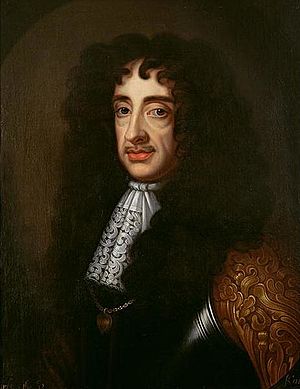
In April 1672, Morgan was sent to London. But instead of being punished, he was treated like a hero. He was never charged with a crime. He even advised the King on how to improve Jamaica's defenses. In November 1674, King Charles II made Morgan a Knight Bachelor, so he became "Sir Henry Morgan." Two months later, Sir Henry Morgan returned to Jamaica to serve as the territory's Lieutenant Governor.
Life in Jamaican Politics
When he arrived in Jamaica, the Assembly of Jamaica voted Morgan a large annual salary for his services. He served on the Assembly until 1683. Three times, he even acted as Governor of Jamaica when the main governor was away.
Morgan was ordered to stop piracy in Jamaican waters. However, he remained friendly with many privateer captains and invested in their ships. He also helped privateers get licenses from the French governor of Tortuga, earning money from each one.
Some officials, like Governor Carbery, complained about Morgan's behavior. Carbery accused Morgan of working with the French to attack Spanish interests. Morgan denied this, saying his meetings were diplomatic. In 1678, the King recalled Carbery, leaving Morgan as temporary governor for three months.
By the late 1670s, France became a growing threat in the Caribbean. Morgan took charge of Port Royal's defenses. He declared martial law (military rule) twice when he was temporary governor. He rebuilt the town's forts and increased the number of cannons.
Morgan and his allies tried to deal with privateers and pirates. However, he faced criticism from former governors. In 1684, an account of Morgan's adventures was published in a Dutch book. This book, by Alexandre Exquemelin, accused Morgan of many bad deeds. Morgan sued the publishers for libel (printing false and damaging statements) and won. The court ruled in his favor, and the book was changed. Morgan stated that he hated "evil deeds, piracies and robberies."
Plantations and Legacy
By the 1670s and 1680s, Sir Henry Morgan owned three large plantations in Jamaica. These plantations used the labor of many enslaved African people. Morgan led campaigns against the Jamaican Maroons, who were communities of runaway enslaved people living in the Blue Mountains. He had some success, but he never managed to capture their leader or fully control their communities.
When Morgan died, he owned 131 enslaved Africans on his estates. He left most of his property to his wife. After her death, his land and the enslaved people were passed to his nephews.
Death and What Happened Next
Morgan died on 25 August 1688 at his estate in Jamaica. The governor ordered a state funeral for him. An amnesty was declared so that pirates and privateers could attend without fear of arrest. He was buried at Palisadoes cemetery in Port Royal, with a 22-gun salute from ships in the harbor. Sir Henry Morgan was a very wealthy man when he died.
On 7 June 1692, a huge earthquake struck Port Royal. About two-thirds of the town, including Palisadoes cemetery and Morgan's grave, sank into Kingston harbor. His body has never been found.
Morgan's Place in History
Morgan is probably the most famous privateer because of Exquemelin's book. However, Exquemelin's book painted a very negative picture of Morgan, possibly because he held a grudge. This portrayal has influenced how historians view Morgan. Some historians even incorrectly wrote that Morgan died in prison.
Exquemelin claimed Morgan's men used widespread torture. While Spanish reports of the raids on Porto Bello and Gibraltar don't mention torture, there are reports that it happened in Panama. It's important to remember that torture was an accepted part of legal questioning in many European countries at that time.
Morgan always fought with a commission from the governor of Jamaica. This meant he was acting as a naval force for the English government. However, the Spanish did not recognize privateering as legal. They considered Morgan a pirate, a label he strongly rejected.
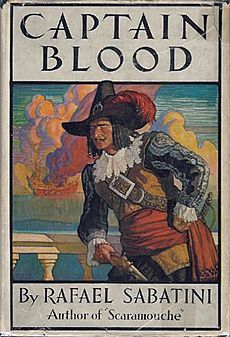
Morgan's story has inspired many fictional works. These include Rafael Sabatini's 1922 novel Captain Blood and John Steinbeck's first novel, Cup of Gold (1929). His name and stories of hidden treasure also appear in other books and poems. He has been featured in several movies and video games, like Sid Meier's Pirates!.
In 1944, the Seagram Company started making the Captain Morgan brand of rum, named after him. The name "Morgan" is also used for places in the Caribbean, like Morgan's Bridge in Jamaica and the Hotel Henry Morgan in Honduras.
Some historians see Morgan as a smart businessman who used his adventures to become a wealthy landowner. He showed how someone could rise in society through daring actions and good business sense. Many Jamaicans and British people saw Morgan as a hero for his actions and for helping Jamaica remain part of the British Empire. However, some Jamaicans view Morgan as a "criminal pirate" who supported the system of slavery.
Images for kids
-
San Carlos de la Barra Fortress, which guarded the entrance to Maracaibo
-
Report from The London Gazette regarding Morgan's successful libel action
See also
 In Spanish: Henry Morgan para niños
In Spanish: Henry Morgan para niños


